Early Exynos 8890 Impressions And Full Specifications
by Andrei Frumusanu on February 21, 2016 6:15 PM EST- Posted in
- Smartphones
- Mobile
- SoCs
- Exynos 8890
- Exynos M1
- Samsung Galaxy S7
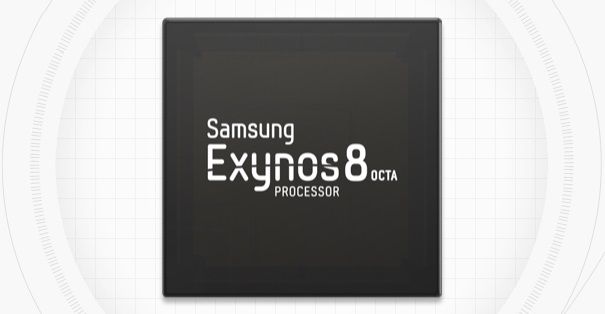
| High-End SoCs Specifications | |||
| SoC | Snapdragon 820 | Exynos 8890 | Exynos 7420 |
| CPU | 2x Kryo@1.593GHz 2x Kryo@2.150GHz |
4x A53@1.586GHz 4x Exynos M1 @ 2.60GHz (1-2 core load) 2.29GHz (3-4 core load) |
4x A53@1.50GHz 4x A57@2.1GHz |
| Memory Controller |
2x 32-bit LPDDR4 @ 1803MHz 28.8GB/s b/w |
2x 32-bit LPDDR4 @ 1794MHz 28.7GB/s b/w |
2x 32-bit LPDDR4 @ 1555MHz 24.8GB/s b/w |
| GPU | Adreno 530 @ 624MHz |
Mali T880MP12 @ 650MHz |
Mali T770MP8 @ 770MHz |
| Mfc. Process |
Samsung 14nm LPP |
Samsung 14nm LPP |
Samsung 14nm LPE |
The Exynos 8890 employs Samsung's own designed Exynos M1 cores. The micro-architecture at a high level resembles ARM's big cores, but Samsung seems to have made quite a few changes and improvements when compared to ARM's designs. While by now I do have a quite good idea of what the Exynos M1 looks like, we'll be covering the topic more in-depth in a future article once we'll be able to gain better insight from our own unit for proper benchmarking and power measurements.
On the CPU side we find an 8-core SoC composed of 4x Cortex A53 cores running at up to 1.586GHz coupled with 4x Exynos M1 cores in a big.LITTLE configuration. The most surprising revelation was the fact that the M1 cores reach an extremely high clock of up to 2.6GHz. This represents quite a significant boost over some past rumors which had put expectations 2.3-2.4GHz maximum frequency range. The catch here is that the Galaxy S7's power management doesn't allow all four cores to run at this high frequency but rather only enables the maximum clock when there's at most 2 cores loaded. If there are 3 or more cores under high load, the CPU frequency doesn't surpass 2288MHz.
On the GPU side we knew that we'd encounter a new ARM Mali T880MP12 - the currently largest Mali implementation available among existing SoCs. Back in November I theorized that Samsung would use the larger core implementation to lower the clocks of the GPU block and thus achieve better power efficiency. Indeed that's what seems to have happened as the Exynos 8890's GPU peaks at 650MHz versus the 770MHz frequency for the Exynos 7420. Hopefully this means that the new SoC will be able to maintain its peak performance for longer periods of time.
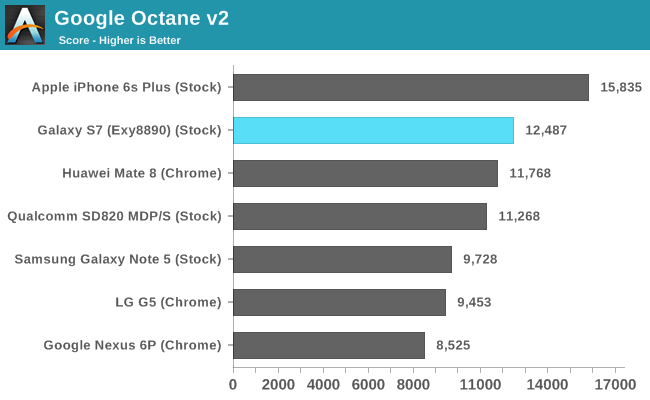
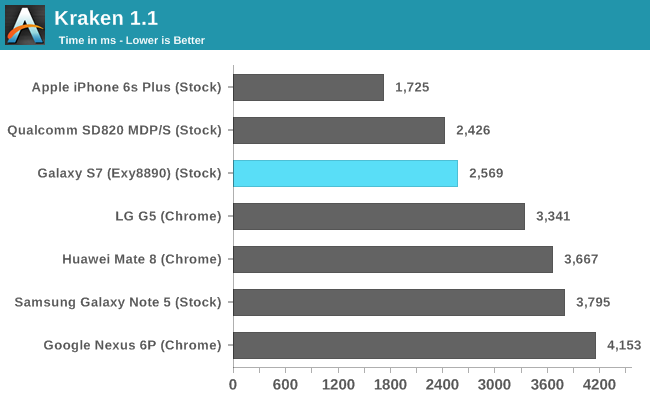
While I didn't have the time to run too many benchmarks, I did manage to run a few of our basic browser tests as well as GFXBench. We haven't had the opportunity to benchmark the Snapdragon 820 Galaxy S7 yet, therefore I included the score numbers of the MDP/S platform to represent a best-case scenario for the Snapdragon 820 until we can get apples-to-apples scores based on Samsung's browser. This still mostly due to the fact that Chrome is seemingly not yet optimized to take advantage of Kryo's new architecture, and as a result scores some rather mediocre numbers, as seen in some preliminary LG G5 numbers included in the graphs above.
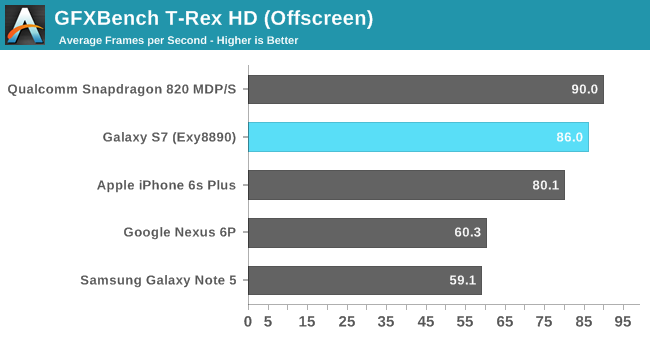
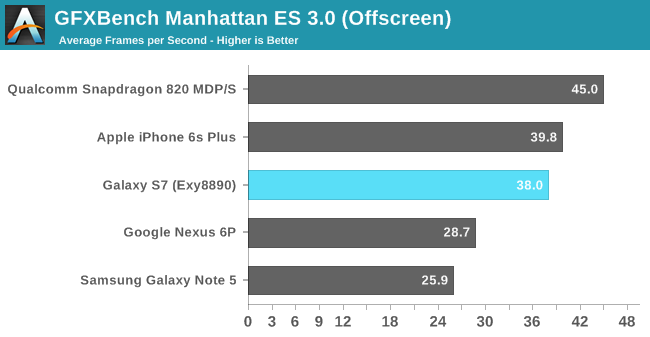
Some quick GPU benchmarks also put the Exynos 8890 slightly behind the Snapdragon 820 in the MDP/S. We will still have to see if actual Snapdragon 820 devices are able to deliver the same performance as the MDP/S platform as there might be some thermal limitations coming into play. Again, we can't comment too much on the scores before we get to know each device's long-term performance and if the attained numbers are sustainable for long periods of time.
One observation I made today which was particularly concerning, was that both with the Snapdragon 820 LG G5 as well as the Exynos 8890 Galaxy S7 got considerably warm after running some heavy workloads. The fact that the Galaxy S7 touts having a heat-pipe thermal dissipation system is a quite worrying characteristic of the phone and should in no way be seen as a positive feature as it points to high power draw figures on the part of the SoC.
The first impression is that the performance difference between the Snapdragon 820 and the Exynos 8890 doesn't seem to be very large, therefore it will be the SoC's power draws and power efficiencies which will determine if, and which one of both will represent a superior design. Hopefully in the coming weeks and months we'll be able to get a better understanding of this new generation of SoCs so that we can paint a definitive picture of the current status of the mobile SoC space.










94 Comments
View All Comments
lilmoe - Sunday, February 21, 2016 - link
Erm... The A9 was beat by the 7420 before it even came out.This cute talk about single threaded performance being the most important factor in MOBILE is nothing but BS. The iPhone 6S major performance improvements over the previous iPhone came from storage speed. Even with that, the S6 wasn't faster at loading apps or webpages compared to the GS6 (among other 2015 Android flagships).
The most processor demanding task 90%+ of users will need is encoding video for sharing, and that takes full advantage of multi-cores (more efficiently so on more cores at that).
For gaming it's all about GPUs. GPUs are ALL about efficiency at this point, not speed. No game can saturate the A9's GPU, and neither the Adreno 430 or Mali T760 MP8. By the time there are games that can, it would already be 2-3 years in.
Let the single-threaded argument go, people. Smartphones aren't the biggest gainers of that aspect of CPU performance.
lilmoe - Sunday, February 21, 2016 - link
****Even with that, the iPhone 6S wasn't faster at loading apps or webpages compared to the GS6EDIT BUTTON FFS.
ciderrules - Monday, February 22, 2016 - link
Sure. And we all know that loading of Apps is the single most important aspect of a device. That's why all the reputable sites (like Anandtech) do extensive App-Loading Benchmark tests rather than benchmarks that test the actual CPU/GPU.lilmoe - Monday, February 22, 2016 - link
Yea, cool browser benchmarks, stress tests, and lots of completely irrelevant, unproven tests that have absolutely no value in real world usage. Keep'em comin'.All these "reputable" sites are confusing PC and workstation benchmarking with mobile. Here's a tip: the keyword is *efficiency*. At least some of these sites are starting to get a clue.
syxbit - Sunday, February 21, 2016 - link
"Let the single-threaded argument go, people."No.
Single threaded performance is still extremely important. It's the reason that JS heavy webpages load much better on an iPhone. Haven't you read the JS perf posts by discourse.org?
I would definitely prefer my Nexus 6P had the A9 chip. Apple's 2 core trounces on Qualcomm's octacore.
Chaser - Sunday, February 21, 2016 - link
And how does the average user experience the difference routinely?syxbit - Sunday, February 21, 2016 - link
I can't post the link, as it triggers the spam filters, but search for 'discourse js performance'They basically say that their JS heavy site is nearly unusable on Android. They're even evaluating their future site because of Android's popularity.
beginner99 - Monday, February 22, 2016 - link
Discourse is also a terrible platform. It's even slow on a desktop compared to other options that fill the same niche.lowlymarine - Sunday, February 21, 2016 - link
"It's the reason that JS heavy webpages load much better on an iPhone."No, the reason that JS heavy webpages load much faster on an iPhone is that Chrome for ARM sucks. I have a friend with a ZenFone 2 (Intel Atom Z3580) and Chrome on it is drastically more fluid than on my Note 5. Similar comparisons are easily drawn with ARM Chromebooks next to their Intel-powered brethren.
BurntMyBacon - Monday, February 22, 2016 - link
@lowlymarine: "No, the reason that JS heavy webpages load much faster on an iPhone is that Chrome for ARM sucks. I have a friend with a ZenFone 2 (Intel Atom Z3580) and Chrome on it is drastically more fluid than on my Note 5. Similar comparisons are easily drawn with ARM Chromebooks next to their Intel-powered brethren."You may be correct. Though to be fair, your example doesn't prove it. Intel's Atom architecture has pretty solid single threaded performance relative to its ARM competitors. So, it could be the software, but it could also be the single threaded performance. I'd assume a little of both.